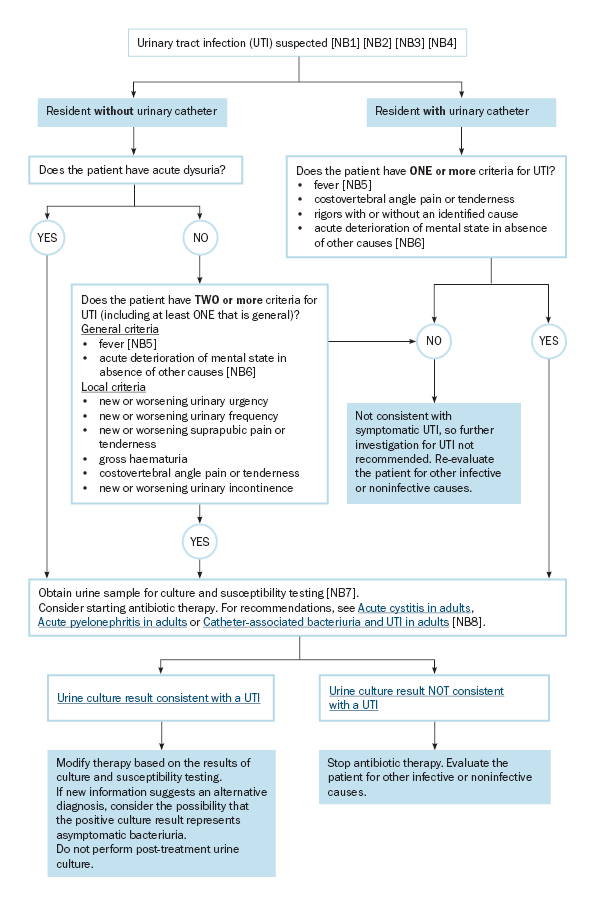Assessment of UTI and bacteriuria in residents of an aged-care facility
The diagnosis of symptomatic urinary tract infection (UTI) in residents of an aged-care facility can be difficult. Validated criteria for diagnosing UTI in residents of an aged-care facility are lacking. Acute deterioration of mental state is often inappropriately used as an indication for starting antibiotics in residents of an aged-care facilityD'Agata 2013Juthani-Mehta 2014Rowe, 2014; for detailed information on the assessment and potential causes of acute deterioration of mental state, see Delirium.
Establish whether an advance care plan is in place and if investigations for UTI are consistent with the expressed goals of the patient.
Residents of an aged-care facility have a high prevalence of bacteriuria, so urine culture is not helpful in evaluating nonspecific symptoms. Acute dysuria is the most specific genitourinary symptom of UTI in residents of an aged-care facility. Cloudy or malodorous urine is not a reliable sign of UTI. Do not investigate (with urinalysis [‘dipstick’ test] or urine culture) or treat cloudy or malodorous urine in the absence of other signs or symptoms of UTI.
If UTI is likely, obtain a midstream urine sample for culture and susceptibility testing. A clean-catch or midstream urine sample may be difficult to obtain. As an alternative, consider sampling urine with an in–out catheter for females1 or a new (unused) condom catheter for males2.
For information on investigations for UTI, see Diagnosis of acute cystitis in adults, Diagnosis of acute pyelonephritis in adults and Diagnosis of acute bacterial prostatitis. There is a higher risk of infection caused by multidrug-resistant bacteria in residents of an aged-care facility; see UTI caused by multidrug-resistant gram-negative bacteria for detailed information.
For the initial assessment and management of suspected UTI in residents of an aged-care facility, see Assessment and treatment of residents of an aged-care facility with suspected urinary tract infection. The To Dip or Not To Dip resource developed by the Aged Care Quality and Safety Commission (ACQSC) can be used to implement the advice in Assessment and treatment of residents of an aged-care facility with suspected urinary tract infection.

NB1: Do not investigate or treat cloudy or malodorous urine in residents of an aged-care facility who do not have other signs or symptoms of UTI.
NB2: Consider whether an alternative diagnosis is likely. Consider both infective (eg pneumonia) and noninfective (eg medication-related adverse events) causes.
NB3: Establish whether an advance care plan is in place as it may influence assessment and management (eg whether investigations are performed or antibiotics given).
NB4: For the diagnosis and treatment of acute bacterial prostatitis, see Acute bacterial prostatitis.
NB5: Fever is defined as a temperature of 38°C or higher or an increase of more than 1.5°C above baseline temperature.
NB6: Acute deterioration of mental state includes new change in level of consciousness, periods of altered perception, disorganised speech and lethargy; see Delirium.
NB7: If the resident has an indwelling urinary catheter, see Guide to collecting urine samples in patients with indwelling urinary catheters for a guide to collecting urine samples in patients with indwelling urinary catheters.
NB8: The duration of therapy does not need to be modified for this patient group and should always be stated on the prescription.
